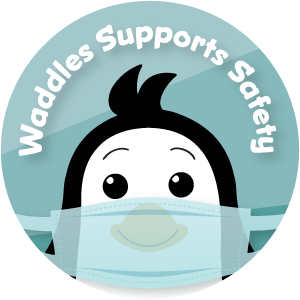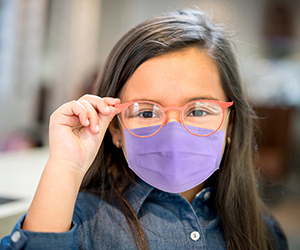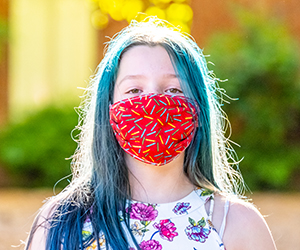Should Kids Wear Masks?
Everything You Need to Know About COVID-19’s Impact on Children and the Do's and Don’ts of Masking
Updated July 21, 2022

With many messages circulating around – from how COVID-19 affects children to the effectiveness of masking – feeling confused about how best to protect your child during the continued COVID-19 pandemic is understandable. To learn the facts, we asked with Munson Healthcare pediatrician Jacques Burgess, MD, MPH and Pediatrics Nursing Manager Amy Culp, MSN, RN.

Are Kids (Ages 0-18) Affected by COVID-19? To What Degree?
Dr. Burgess — The short answer is, yes, children are susceptible to becoming infected with and spreading COVID-19, including any new variants that may develop. They can become infected with COVID-19, and they can spread COVID-19 to others.
How the virus impacts kids personally is similar to its effects on adults: many kids show no symptoms, while others feel minor symptoms, such as a cough. According to the World Health Organization (WHO), current evidence suggests that children are less likely to become severely ill from COVID-19, but these severe cases in children do exist.
We’ve also witnessed some cases where children are contracting Respiratory syncytial virus (RSV) alongside COVID-19, which has the potential to be dangerous and may lead to hospitalization, particularly in the very young or immunocompromised – as can Multisystem inflammatory syndrome in children (MIS-C).
Based on this Evidence, Should Children, Like Adults, Wear Masks?

Amy Culp— When our COVID-19 community level is high, children ages 2 and older should wear masks in indoor public settings in addition to continued physical distancing. This guidance applies to children with normal and healthy respiratory health, with no visible or history of breathing problems.
Additionally, masks should not be worn by anyone who is unconscious, incapacitated, or otherwise unable to remove the mask without assistance. This applies to any age.
Does this apply to just public indoor spaces – or outdoor too?
Amy Culp— Play, both indoors and out, is so important for children and aids in their development. Determining a location’s ventilation is key for deceasing potential exposure. Improving ventilation with child-safe fans, opening windows, and encouraging outdoor activities when possible is recommended.
What Kinds of Masks are Suitable for Kids? Are Fabric Masks Protective Against the Virus?
Dr. Burgess— The World Health Organization (WHO) is actively studying and encouraging research on the science of masks. New research findings identified the following fabrics, number of layers, and the composition of a non-medical, fabric mask:
-

an inner layer of absorbent material such as cotton
- a middle layer of non-woven material such as polypropylene
- an outer layer of non-absorbent material, such as polyester or polyester blend
Whether you are purchasing or making masks based on these criteria, the mask should allow you to breathe easily while talking or taking a brisk walk.
One note of caution: relying on a fabric mask as your only safeguard does not provide a sufficient level of protection against COVID-19. Safety measures such as physical distancing of 6 feet or more and frequent handwashing play a critical role in stemming the spread of this disease! So rather than relying on masks as you and your family's sole protection, think of them as an additional layer of protection that works in tandem with other precautions.
Think about how we use sunscreen. While it offers a layer of protection against harmful sun rays, the ultimate protection is adding sunscreen to additional sun-blocking measures, such as long sleeves, covered shelters or umbrellas, and avoiding outdoor spaces during peak UV hours. A mask works much the same. It provides you and your child with an additional safety layer when combined with other safeguards, particularly when you're in situations where physical distancing is difficult, such as the grocery store or a confined space with crowds.
What about vaccinated children – do they still need to wear a mask?
Dr. Burgess – The COVID-19 vaccines are highly effective in preventing severe COVID-19 symptoms and even hospitalization. In fact, the vast majority of hospitalized cases are currently among the unvaccinated. However, some variants are highly transmissible even among vaccinated people. So essentially, kids can still spread these variants.
Is There a Correct Way for Kids to Wear Masks?
Dr. Burgess—Absolutely. Let’s take a look at the do's and don'ts of helping your child put on, wear, and take off their mask.

Getting started. It's important to encourage your child to wash their hands before handling a mask – and the same goes for anyone assisting. With clean hands, hold the mask by the ear loops and look for tears or holes because a damaged mask won't give much protection.
Use the same ear loops to put the mask on, rather than grabbing the front of the mask. With young kids who want to put their own masks on, you could use a friendly analogy they'll understand, such as using the mask's "ears" or "wings" to put it on.

Mask wearing. Next, just like with adults, the mask should cover your child's mouth, nose, and chin without creating gaps at the sides where germs can enter. Once your child's mask is on, be sure to change it if it gets dirty or wet. For these reasons, I recommend traveling with an extra mask or two, since we know kids will be kids, and their masks may get contaminated or compromised during play or exploration.
Mask removal. Be sure to practice handwashing again before either you or your child removes their mask, which should be done from the ear loops, rather than the front of the mask. Place the mask (if clean) in a clean bag that can be resealed, such as a plastic storage bag. Next, it's time to wash those hands again, since you or your child might have come in contact with germs while removing the mask.
Washing dirty or wet masks. Wash masks once per day with soap or detergent and warm water (at least 60 degrees in temperature). You can use room-temperature water if you boil the mask in hot water for 1 minute or soak it in 0.1% chlorine for 1 minute before rinsing.
Avoid sharing. Kids have big hearts. That's why it's important to discourage them from sharing or “trading” their mask with others. Teach them that the mask is special and solely for their own use.
Do Masks Pose any Kind of Safety or Health Threat to Kids?
Amy Culp—Some parents and caregivers are concerned about the impact masks can have on their child's breathing, development, or mental health. These are valid concerns and there are many things we adults can do to help address them.
However, before I dive into that, I want to stress two important reminders:
- Children ages 2 and under should not wear masks
- Kids should wear masks only under adult supervision
Masks and your child's breathing. In most cases, masks should not impact the natural breathing process. Younger children (e.g., preschool or early elementary-aged) may be unable to wear a mask properly, particularly for an extended period of time. We recommend prioritizing masks for during times when it's difficult to maintain a distance of six feet from others (for example, during carpool drop-off or pick-up, or when standing in line at school).
Also, ensuring proper mask size and fit and providing children with frequent reminders and education on the importance and proper wearing of masks may help address these issues.

Masks and mental health. Watch for signs of stress in your child. Some common signs include excessive worry or sadness, unhealthy eating or sleeping habits, and difficulty with attention and concentration. For more information, see the CDC’s Managing Stress.
Taking time to talk with your child or teen about the COVID-19 outbreak is really helpful. Answer questions and share facts about COVID-19 in a way that your child or teen can understand.
Anotther helpful resource you can lean on is the CDC’s Helping Children Cope with Emergencies.
When and Where Should Kids Wear Masks?
Dr. Burgess—

During times when your COVID-19 community level is high and you're in a setting where physical distancing of six feet or more may not be possible – such as the grocery store – a mask could be a helpful barrier to limit the spread of airborne droplets. Again, I cannot emphasize enough the importance of frequent handwashing and physical distancing whenever possible when you do leave home.
If you or your child is sick or symptomatic - such as fever, cough, congestion, runny nose, diarrhea, or vomiting – I recommend staying at home and calling your family doctor or pediatrician. Your doctor can advise you through a virtual visit or whatever makes sense based on the symptoms.
How Can I Make Mask-Wearing More Fun and Less Scary for my Child?
Amy Culp—
Use a gentle, child-friendly approach. Explain that masks help protect them and others from germs, and the places/situations where it's important to wear them. You might even try talking to them in front of a mirror with masks on so they can see the masks in use while you're talking about them.
Model rather than force. Parents and caregivers should wear a mask so your child doesn't feel alone. You could also mask one of their favorite toys or animals or draw a mask over one of their favorite characters in a book or coloring book to help enforce the message that everyone they feel close to is wearing one when needed. Finally, pointing out photos of other children wearing masks could help normalize the idea of masking when necessary.

Let kids choose their own mask or fabric. Giving your child options helps foster a sense of empowerment. Studies show that giving kids a sense of control helps encourage cooperation, among other benefits. You could also suggest getting matching masks and talk about how you’re a team.
Provide rewards. Incentives like stickers, extra playtime, or whatever rewards you feel comfortable giving your child can help reinforce mask wearing and proper use. Focus on positive reinforcement, calling attention to the things they do right, such as washing their hands after touching their mask, versus punishing or scolding their mistakes.
Talk to them in advance when they will need to wear so they can prepare. Children often respond better when they can prepare in advance. If you are going to the store or a public place where social distancing will be limited, let your child know at least an hour in advance so they can grow accustomed to the idea and mentally prepare.
Also, below are some fun printables that can help with smaller children: